Chapter: Biology: Structural Organization and Acquaintance of Animals
Skeletal system of Toad
Skeletal system of Toad : The system which gives the body its structure, adefinite shape and protects the soft organs (like heart and lungs) is called skeletal system. The skeletal system of toad is mainly formed by the combination of bones and cartilages. Bones of the skeleton remain attached with one another by various muscles and ligaments. The skeleton of toad is mainly divided into two categories, Axial skeleton and Appendicular skeleton.
Axial skeleton : The axial skeleton is situated along the mid dorsal line of thebody and is formed by the combination of skull and vertebral column. The axial skeleton is extended from the anterior end of the head to the posterior end of the body.
Skull : The part of the axial skeleton which forms the frame of the head andprotects the brain is called skull. It consists of various small and large bones. A skull has different parts, such as cranium, upper jaw, lower jaw, nasal, capsule eye cavity, ear cavity, hyoid apparatus etc.
The small cavity at the middle of the head surrounded by small bones, in which the brain lies, is called the cranium. At the posterior part of the cranium there is a big aperture called foramen magnum. Through this opening the spinal cord comes out from the brain and enters the vertebral column. At the floor of the buccal cavity of the toad, there lies a plate like structure made of cartilage called hyoid apparatus. Upper and lower jaws surround the mouth aperture. The upper jaw is firmly attached with the cranium but the lower jaw can move up and down. In the wall of the cranium there are several paired pores. Through these pores the cranial nerves from the brain comes out.
Functions of skeleton : The skeleton does the following functions:
a. It gives structure and firmness to the body- The skeleton forms the hardstructure of the body and gives it a definite shape.
b. It protects soft organs - The skeleton protects the important soft organs ofthe body such as, heart, lungs, brain, etc.
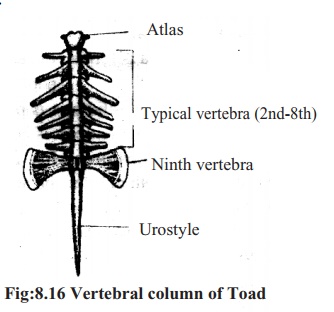
c. It stores fat and produces blood corpuscles- White bone marrow stores thefat and red bone marrow produces the red blood corpuscles.
d. It helps in the attachment of muscles- Skeleton forms the surface forthe attachment of muscles, muscle ligaments and mesenteries and helps in keeping the various organs of the body in definite positions.
e. It carries the weight of the body and assists in locomotion-The coordinationof skeleton an skeletal muscles helps in carrying the weight and movement of the body.
Vertebral column: The vertebral column is extended from back of the head tillthe posterior end of the body of the toad. It is also called the backbone. Vertebral column surrounds the spinal cord. The vertebral column of the toad is formed by nine ring like bones called Vertebrae and a long bone called Urostyle. The structure of the first and ninth vertebra of the vertebral column is different. The structure of the second to eight vertebrae are almost alike.
Atlas: The first vertebra of the vertebral column is called the atlas. It isconnected with the skull in front and the second vertebra (at the posterior). The atlas looks like a ring. It has no transverse process, neural spine and prezygapophysis. Its neural canal is comparatively bigger in size. Atlas meets the next vertebra with the help of post zygapophysis.
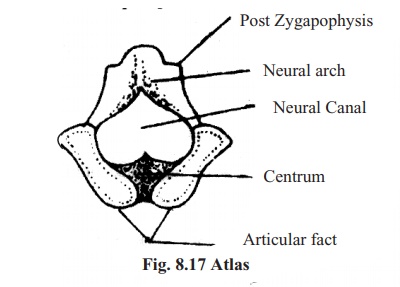
Typical vertebra:
An ideal vertebra is formed of centrum, neural canal, neural arch, neural spine,
transverse process, pre-zygapophysis, and post-zygapophysis.
a. Centrum: This solid part is present in the middle of the ventral surface ofevery vertebra. Its front part is concave and the back part is convex. This type of centrum is called procoelus. Due to this structure, the vertebrae can easily be attached to both in front and at the back.
b. Neural canal: The cavity surrounded by the neural arch is called neuralcanal. The spinal cord Passes backward through this.
c. Neural arch: The tip two bones generating from the two sides of the dorsalsurface of the centrum forms a circular ring. This ring is called the neural arch, which surrounds the spinal cord.
d. Neural spine: Two neural arches joining together form a spine like process.This spine like part is the neural spine, muscles attaching with it gives the body firmness.
e. Transverse process: From the side of every neural arch, a long bone extendstransversely. This bone is known as transverse process. Different muscles are attached with the process.
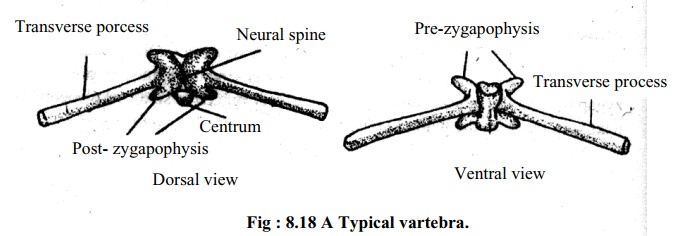
f. Pre-zygapophysis: The up looking spoon like thick fold that comes out fromthe front of every neural arch is called pre-zygapophysis. It gives the body firmness by attaching itself with the two post-zygapophysis of the vertebra in front.
g. Postzygapophysis: The two down looking spoon like folds that come outfrom the back of every neural arch are called posti-zygapophyss. They remain attached with the pre-zygapophyses of the posterior vertebra. As a result the attachment of the vertebrae becomes firm.
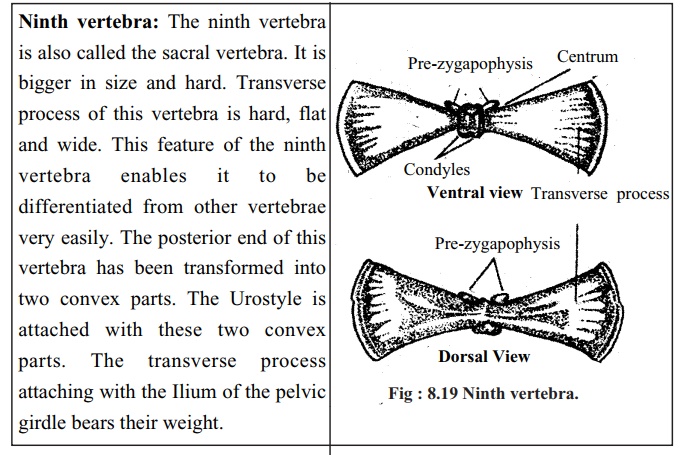
Urostyle: Urostyle is a long rod shaped bone situated at the back of the ninthvertebra. Several vertebrae are fused together to form this structure. It is situated at the end of the vertebral column in between the two iliums. On the dorsal side of this bone there is a knife-like ridge called neural crest, and the bone is gradually narrowed towards the back. The concave part of the front end of the urostyle remains attached with the convex part of the ninth vertebra. There is very fine neural canal between this concave facet and neural crest.
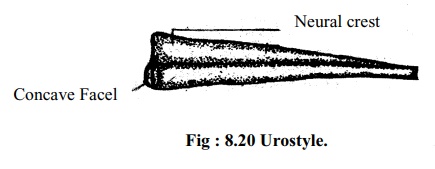
Functions of vertebral column:
1. The vertebral column by giving a definite shape forms to the frame of the body.
2. It surrounds the spinal cord and protects it.
3. Being attached with the pelvic girdle it assists in bearing the weight of the body and its movement.
4. Being attached with the transverse process and neural arches of the muscles, vertebrate make the movement smoother.
Appendicular skeleton: The appendicular skeleton of toad is divided into tworegions, one is Girdle region and the other is Limb region.
In the body of toad there are two girdles. The fore limb is attached with the anterior girdle or the pectoral girdle. Similarly the hind limb is attached with the posterior girdle or the pelvic girdle.
Pectoral girdle: The pectoral girdle almost encircles the anterior part of thetrunk region of the body. It occupies almost the whole interior region of the body excepting the midline of the dorsal side. This part is covered with skin and muscle. The pectoral girdle of toad can be divided into two equal or symmetrical parts. Each symmetrical part is formed with the combination of bones and cartilages. This girdle remains attached with the backbones by muscles as a result of which by keeping it in a proper place, completion of different types of work becomes very easy.
Functions:
1. Pectoral girdle holds the fore limb.
2. It protects the soft organs of the body such as lungs, heart etc.
We have known earlier that the pectoral girdle can be divided into two similar parts. Each part consists of the following components:
a. Supra-scapula: It is a wide, plate like cartilage. One end of the supra -scapula is joined with the scapula and the other end remains free. The free end is attached with the backbone by muscles and ligaments.
b. Scapula: Scapula is a narrow hard long bone. One end of this bone isattached with the supra-scapula and the other with the clavicle and coracoid.

c. Clavicle: Clavicle is a narrow and long bone. It is also called collar bone.This bone is situated in front of the scapula and it covers the pre-coracoid. Its one end takes part in the formation of scapula and the other end in the formation of glenoid cavity.
d. Coracoid: This bone is hard bulky and thick. One end of the coracoid, whichis attached with the scapula, forms the glenoid cavity and the other end is joined with the precoracoid.
e. Precoracoid: It is an axe-like part formed from a long and narrow cartilage.Precoracoid is situated at the bottom and side of the clavicle and remains enclosed by the clavicle.
f. Epicoracoid: It is a bent cartilage whose one end is joined with the coracoidand the other end with the precoracoid.
g. Glenoid cavity: In every half of the pectoral girdle there is a cavity inbetween the junction of scapula, coracoid and clavicle. This cavity is known as glenoid cavity.
h. Sternum: At the ventral side of the body there is an expanded part made ofcartilage behind the coracoid of the two halves of the pectoral girdle, it is called the sternum. The posterior end of the sternum is rounded in toad.
Fore limb
The fore limb of toad is formed by the combination of some small and large, bones. The description of these bones is given below:
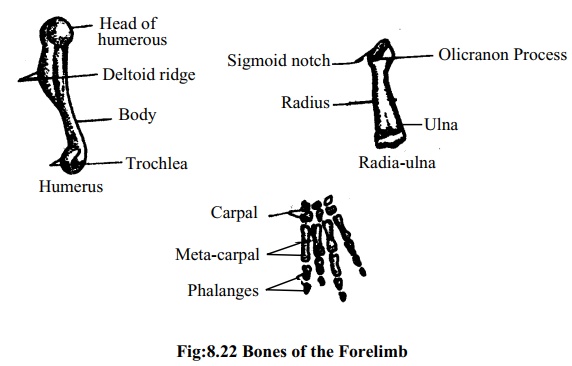
a. Humerus: The upper most bone of the fore limb is called the humerus. It islong and slightly bended. Both ends of the bone are stout. A ridge called the deltoid ridge is found on the upper of the humerus. The head of the anterior part of the bone is round. With this head, the humerus remains attached with the glenoid cavity of the pectoral girdle. At the other ends of the humerus, lies a rounded bone mass. It is known as trochlear process. It helps in attaching itself with the next bone.
b. Radia-ulna: The middle bone of the fore limb of toad is the radia-ulna.Actually this bone is formed by fusion of two bones the radius and the ulna. At the junction of the two bones there lies a longitudinal mark. The bone in the inner side is known as radius and the one located outer side is known as the ulna. In front of this bone there is a carve known as sigmoid notch. The trochlear of humerus is jointed there. Near the notch there is a projection called olecranon process.
c. Carpal: The carpal is formed by the six small bones of the wrist. With threebones in each row, a total of six bones are arranged in two rows. The posterior end of radia-ulna is joined with the carpals.
d. Metacarpal: The palm is formed with four narrow bones. These bonesare called metacarpals. They bear the weight of the palm of forelimb and remain attached with the phalanges.

e. Phalanges: In the forelimbs of toad, there are four fingers. The finger-bones are called phalanges. There are two phalanges on the first and second. Fingers and three on the third and fourth fingers.
Pelvic girdle: The pelvic girdle can also be divided into twoequal parts like the pectoral girdles. This girdle attaches the hind limb with the backbone and bears the weight of the body. This girdle looks like English letter `V''. Each part of the pelvic girdle consists of three separate bones and one cavity.

a) IIium : The longest bone of pelvic girdle which isslightly bent and rod shaped is called ilium. Its front end remains attached with the ninth vertebra.
b) Ischium: It is a semi lunar bone situated between theilium and pubis.
c) Pubis: It is a triangular cartilage situated between iliumand ischium.
d) Acetabulum: A cavity situated at the junction of thethree bones of the pelvic girdle is called the acetabulum. With the acetabulum the head of the femur of the hind limb remains attached.
Hind limb:
a. Femur: The first solid bone of hind limb is femur. Thetwo ends of the femur are swollen and the middle portion is bent. The rounded part of the anterior end remains attached with the acetabulum.
b. Tibia-fibula : The knee bone is called tibia-fibuala. Thisbone is formed by the fusion of two. bones named tibia and fibula. The tibia is situated in the inner side of the body and the fibula is in the outer side. There is a ridge at the junction of the two bones, known as cnemial crest.
c. Tarsals: The ankle bones of the feet are called tarsal. These bones arranged in two rows. The two bones of the upper row are known as astragalus and calcanium. The ends of these bones bear cartilages. The space between the two bones is hollow. The two bones of the second row are small and shapeless
d. Metatarsal: The sole of the foot of toad is formed of five narrow stick-like bones. These bones remain attached with the phalanges at the lower portion.
e. Phalanges: In the hind limb of toad there are five fingers. There are two phalanges in the first and second fingers, three in the third and fifth fingers and four in the fourth finger. Besides, towards the inner side of the hind limb there is a bony extension named calcar.
Related Topics